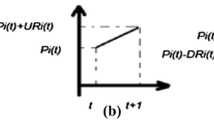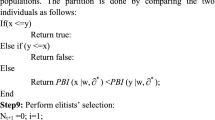Abstract
This paper compares the performance of three population-based algorithms including particle swarm optimization (PSO), evolutionary programming (EP), and genetic algorithm (GA) to solve the multi-objective optimal power flow (OPF) problem. The unattractive characteristics of the cost-based OPF including loss, voltage profile, and emission justifies the necessity of multi-objective OPF study. This study presents the programming results of the nine essential single-objective and multi-objective functions of OPF problem. The considered objective functions include cost, active power loss, voltage stability index, and emission. The multi-objective optimizations include cost and active power loss, cost and voltage stability index, active power loss and voltage stability index, cost and emission, and finally cost, active power loss, and voltage stability index. To solve the multi-objective OPF problem, Pareto optimal method is used to form the Pareto optimal set. A fuzzy decision-based mechanism is applied to select the best comprised solution. In this work, to decrease the running time of load flow calculation, a new approach including combined Newton–Raphson and Fast-Decouple is conducted. The proposed methods are tested on IEEE 30-bus test system and the best method for each objective is determined based on the total cost and the convergence values of the considered objectives. The programming results indicate that based on the inter-related nature of the objective functions, a control system cannot be recommended based on individual optimizations and the secondary criteria should also be considered.






Similar content being viewed by others
References
Carpentier J (1962) Contribution to the economic dispatch problem. Bulletin Society Francaise Electriciens. 3:431–47
Dommel HW, Tinney WF (1968) Optimal power flow solutions. IEEE Trans. Power Apparat. Syst. 1866–1876.
Mohapatra A, Bijwe PR, Panigrahi BK (2013) Optimal power flow with multiple data uncertainties Electr. Power Syst. Res. 95:160–167
Zehar K, Sayah S (2008) Optimal power flow with environmental constraint using a fast successive linear programming algorithm: Application to the algerian power system. Energy Convers. Manage. 49:3362–3366
Shahidehpour M, Ramesh V (1996) Nonlinear programming algorithms and decomposition strategies for OPF. IEEE/PES Tutorial on Optimal Power Flow.
Lipowski J, Charalambous C (1981) Solution of optimal load flow problem by modified recursive quadratic-programming method. IEE Proc. Generat. Transmiss. Distribut. 128:288–94
Capitanescu F, Glavic M, Ernst D, Wehenkel L (2007) Interior-point based algorithms for the solution of optimal power flow problems. Electric Power systems research. 77:508–17
Sun DI, Ashley B, Brewer B, Hughes A, Tinney WF (1984) Optimal power flow by Newton approach. IEEE Trans. on Power Apparat. and Systems. 2864–2880.
Kumari MS, Maheswarapu S (2010) Enhanced genetic algorithm based computation technique for multi-objective optimal power flow solution. Int. Journal of Electr. Power Energy Syst. 32:736–742
Sood YR (2007) Evolutionary programming based optimal power flow and its validation for deregulated power system analysis. Int. Journal of Electr. Power Energy Syst. 29:65–75
Hegazy O, Mierlo JV, Barrero R, Omar N, Lataire O (2012) PSO algorithm-based optimal power flow control of fuel cell/supercapacitor and fuel cell/battery hybrid electric vehicles. COMPEL: The International Journal for Computation and Mathematics in Electrical and Electronic Engineering 32(1):86–107
Yuan Y, Xiaohui Y (2010) An improved PSO approach to short-term economic dispatch of cascaded hydropower plants. Kybernetes. 39(8):1359–1365
Jeon YJ, Kim JC (2004) Application of simulated annealing and tabu search for loss minimization in distribution systems. Int. Journal of Electr. Power Energy Syst. 26:9–18
Abou El, Ela A, Abidob MA, Spea SR (2010) Optimal power flow using differential evolution algorithm, Electric Power Syst. Res. 80:878–885
Yammani C, Maheswarapu S, RajMatam S (2012) Multiobjective Optimization for Optimal Placement and Size of DG using Shuffled Frog Leaping Algorithm. Energy Procedia. 14:990–995
Rajasomashekar S, Aravindhababu P (2012) Biogeography based optimization technique for best compromise solution of economic emission dispatch. Swarm Evolut, Comput
Ayan K, Kılıç U (2012) Artificial bee colony algorithm solution for optimal reactive power flow. Applied Soft Computing.
Sivasubramani S, Swarup K (2011) Multi-objective harmony search algorithm for optimal power flow problem. Int. Journal of Electr. Power Energy Syst. 33:745–752
Boyd S, Kim SJ, Vandenberghe L, Hassibi A (2007) A tutorial on geometric programming. Optimization and engineering. 8(1):67–127
Zhou A, Qub BY, Li H, Zhaob SZ, Suganthan PN (2011) Zhangd Q (2011) Multiobjective evolutionary algorithms: A survey of the state of the art. Swarm Evolut, Comput
Wang L, Singh C (2008) Stochastic combined heat and power dispatch based on multi-objective particle swarm optimization. Int. Journal of Electr. Power Energy Syst. 30:226–234
Sheng W, Liu Y, Meng X, Zhang T (2012) An Improved Strength Pareto Evolutionary Algorithm 2 with application to the optimization of distributed generations. Computers & Mathematics with Applications.
Kusiak A, Zheng H (2010) Optimization of wind turbine energy and power factor with an evolutionary computation algorithm. Energy. 35:1324–1332
Deb K, Pratap A, Agarwal S, Meyarivan T (2002) A fast and elitist multiobjective genetic algorithm: NSGA-II. IEEE Trans. Evolut. Compu. 6:182–197
Babu B, Anbarasu B (2005) Multi-objective differential evolution (MODE): an evolutionary algorithm for multi-objective optimization problems (MOOPs).
Wen F, Chang C (1997) Transmission network optimal planning using the tabu search method. Electric Power Syst. Res. 42:153–163
Elbeltagi E, Elbeltagi E, Hegazy T, Grierson D (2005) Comparison among five evolutionary based optimization algorithms. Advanced Engineering Informatics. 19:43–53
Costa GRM, Costa CEU, Souza AM (2000) Comparative studies of optimization methods for the optimal power flow problem. Electric Power. Syst. Res. 56:249–254
Vlachogiannis JG, Lee KY (2006) A comparative study on particle swarm optimization for optimal steady-state performance of power systems. IEEE Trans. Power Syst. 21:1718–1728
Thukaram BD, Parthasarathy K (1996) Optimal reactive power dispatch algorithm for voltage stability improvement. Int. J Elec. Power Energy Syst. 18:461–468
Kennedy J, Eberhart R (1995) Particle swarm optimization. 4:1942–1948
Fogel LJ, Owens AJ, Walsh MJ (1966) Artificial intelligence through simulated evolution. Wiley.
Kahourzade S (2012) Optimal power flow based on evolutionary programming, master thesis, University of Malaya.
Wong KP, Wong YW (1994) Genetic and genetic/simulated-annealing approaches to economic dispatch. IEE Proc. Generat. Transmiss. Distribut. 141(5):507–513
Sheblé GB, Brittig K (1995) Refined genetic algorithm-economic dispatch example. IEEE Trans. Power Syst. 10:117–124
Fogel DB (1995) A comparison of evolutionary programming and genetic algorithms on selected constrained optimization problems. Simulation. 64:397–404
Sung YC, Su CK (2010) Fuzzy genetic optimization on performance-based seismic design of reinforced concrete bridge piers with single-column type. Optimization and Engineering. 11(3):471–496
Author information
Authors and Affiliations
Corresponding author
Appendix
Appendix

Rights and permissions
About this article
Cite this article
Kahourzade, S., Mahmoudi, A. & Mokhlis, H.B. A comparative study of multi-objective optimal power flow based on particle swarm, evolutionary programming, and genetic algorithm. Electr Eng 97, 1–12 (2015). https://doi.org/10.1007/s00202-014-0307-0
Received:
Accepted:
Published:
Issue Date:
DOI: https://doi.org/10.1007/s00202-014-0307-0




